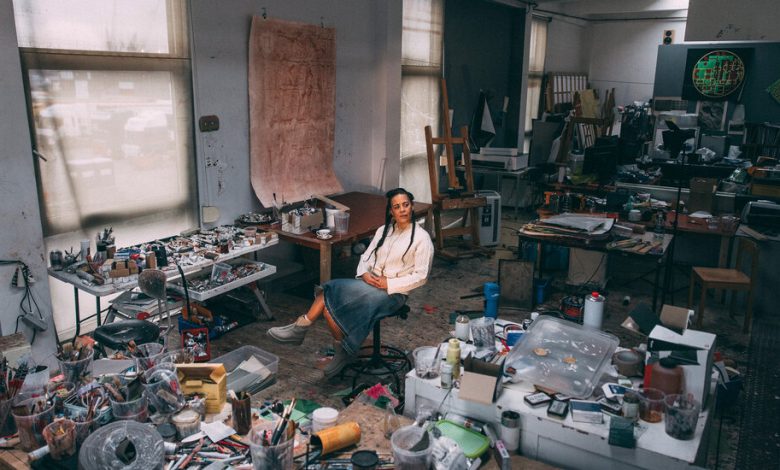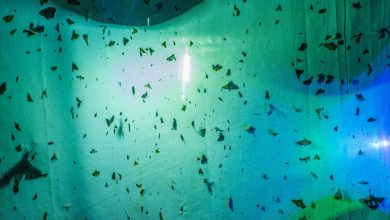Ellen Gallagher’s Futuristic Archives

A fire erupted at the American artist Ellen Gallagher’s studio in Rotterdam, the Netherlands, in 2004. None of her paintings were damaged — she’d been installing them in a show in New York at the time — but she was left without a work space for some time. “I’d been making these massive Plasticine resin paintings. I was so into it. I’d just shown in the Venice Biennale, and I wasn’t ready to not make something ambitious,” she says. But the fire forced her to shift formats and work on a smaller scale. Those limiting conditions, somewhat ironically, led to her creating perhaps one of her best known bodies of work, “DeLuxe” (2004-5), a collection of 60 absurdistimages composed of vintage clippings from African American magazines such as Ebony, Our World and Sepia. She made collages of the cutouts and turned them into photogravures, a printing process that smoothed the various clippings into one flat image. Then she repeated the process, adding new images atop the existing prints and creating a layered, rich composition. “I love the idea that you can both destroy and maintain the archive,” she says.
On a cold day in February, we sit in that same building, a postwar former tin storage facility. Gallagher’s studio is a sprawling space with large windows and a wooden floor, part of which she and a friend built themselves. Scattered around us are some of her artworks in progress; stacks of paper, brushes and books; and a plate of Dutch cookies. Gallagher moved to Rotterdam from the U.S.two decades ago, out of a desire to distance herself from the demands of the New York art scene. It isn’t much of a walking city, she tells me. The landscape is industrial, flattened out and lined with wide paths that are more suited for cycling than the kind of sauntering one might do in Amsterdam, but Gallagher, an avid biker, prefers Rotterdam’s “spooky,” sparse scenery. The building is divided into multiple studios, primarily shared among 10 core artists. “We’re a [co-op], and everybody has an equal vote,” she says, before adding that the building is very male, in contrast to her artistic community in New York: “I miss a woman’s culture.”
Gallagher was born in Providence, R. I., in 1965 to a working-class family. In her 20s, she worked asa carpenter in the Pacific Northwest and as a fisherman in Alaska; moving away from home had always appealed to her. “That was my right,” she says, “something that was part of making myself as a young adult.” Those early jobs, in which she worked with her hands and engaged with the natural world, eventually led her to pursue an artistic practice that includes painting, drawing, collage, film and animation. After graduating from the School of the Museum of Fine Arts in Boston, she debuted on the New York scene in 1995 with abstract works that included references to ’90s hip-hop culture, ’50s Black hair ads and Jim Crow-era blackface visuals. In her early painting “Oh! Susanna” (1995), which is dense with bulging eyes and “Sambo lips,” the allusion to minstrel cartoons is frank and direct. But it and other works were often flatly interpreted as highlighting, rather than subverting, the signs and symbols of racism. “When I first appeared in the ’90s, the first people reviewing the work were older white men,” Gallagher says. “What I didn’t know as a younger artist was that the misreading was purposeful. Being locked into someone else’s lack of sight, lack of vision: that was the point.”
Over the course of 30 years, Gallagher has carefully attended to her own visual language, deploying processes such as collage, erasure, extraction, reconstruction and revision to create works that blend elements of history, humor and horror. Her recent solo exhibition, “All of No Man’s Land Is Ours,” at the Stedelijk Museum in Amsterdam, explored her longtime preoccupation with marine life, the Middle Passage and the transportation of enslaved people. Gallagher is particularly interested in the phenomenon of whale falls — whale carcasses that sink to the ocean bed — and their resemblance to sunken slave ships. In her canvas painting “Whale Falls” (2017), currently featured in the exhibition “Entangled Pasts”at The Royal Academy in London, a backdrop of sea blues is haunted by the faint suggestion of body parts; the work is also a nod to another of the artist’s enduring interests, the Drexciya myth of an underwater Black civilization populated by the unborn children of pregnant African women thrown overboard from slave ships.



